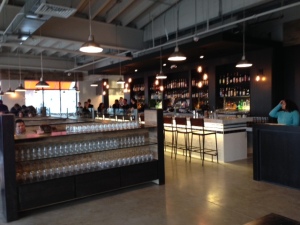By: Nahum Goldberg, LEED AP
Senior Associate/Project Manager – San Francisco Office
Despite health concerns related to the consumption of fried foods, frying will still have its place on many restaurant and institutional menus, and most commercial kitchens are still being equipped with fryers. Vegetable frying oil, after repeated exposure to heat and food elements in the fryer, degrades and must be exchanged for fresh oil. Proper handling and recycling of the used oil integrates sustainable values and good business practices since the used oil has considerable value to the burgeoning biodiesel industry. Additionally, how the operator handles used oil is critical to worker safety and to the overall cleanliness of the facility.
Initially An Environmental Challenge
Spent cooking oil from fryers should never be poured down the sewer drain because it can solidify and clog sewer systems, causing huge costs for property owners and water districts. Local and national laws and codes require that the oil be captured before entering the public sewer lines. Oil that does get through pollutes waterways and clogs ground water absorption systems.
While not the main focus of this article, incidental spills and oily residue is often washed down the drain while cleaning the kitchen or processing food. As a result, in-line oil and grease interceptor tanks are used to collect the grease and oil before it hits the public sewer system. Required in commercial food service facilities, such central grease capturing devices must be emptied regularly, and the oil must be disposed of properly by specialized service companies. Installing these devices and contracting with removal vendors is a cost that must be borne by the owner or operator.
On the other hand, the disposal of fryer oil – initially seen as a cost of being environmentally responsible – has turned into a financial plus for operators.
Waste Vegetable Oil – A Commodity With Increasing Value
As most operators/ managers know, waste vegetable oil has become a highly sought after, valued commodity. The value of the used oil fluctuates based on commodity prices for “yellow grease” and biofuels. One only needs to Google the words “stolen cooking oil” to see pages and pages of recent news reports on sophisticated oil theft operations all over the country – New York, Atlanta, Los Angeles to mention a few. This is no surprise since the value of biodiesel has risen from about nine cents per gallon ten years ago to well over $3 a gallon recently, in line with oil price increases in general.
National and regional oil collection companies actively are seeking new business and will compensate (rebate) for the used oil. There are generally no collection equipment costs when food service operators enter into a contract with an oil collection service. The collectors are eager to get the oil and make their profit from reselling or processing it. Contracts may contain variable pricing or may “lock in” to long-term prices, may depend on volume and quality of collected oil, and may be tied to the commodity price for “yellow grease”. Some local companies encourage a donation program whereby operators can opt to give their proceeds to local schools and non-profits – or alternatively the operator can receive a quarterly check. As in any service or product offering, learning the local offerings, terms and contract details will prove valuable in negotiating the agreement with an oil collection firm.
What to Do With Fryer Oil??
Let’s discuss briefly some options for handling waste vegetable oils – and don’t forget – always check local building department and waste water district requirements for your area and application.
For the small establishment or caterer, even a few gallons of oil need to be handled properly. Once cooled, return to original packaging, seal well and label. Seek a local recycler or disposal method compatible with local codes. Local waste districts will usually have drop off locations for residents. Regional processors such as Sirona Fuels in N. California or The Alternative Fuel Foundation in the Northeastern U.S. can provide you with locations for delivery, and in some cases will even pick up smaller quantities of oil. See links below for more info.
For small restaurants, with a low-to-mid volume of used oil, the best solution is to drain the cooled oil to a bucket and transfer either to the original containers or out to a 55 gallon drum in the dock area for collection. Drums are usually provided free of charge by the collector. A tremendous step up from schlepping buckets of oil around is to use an oil transport unit, available from the prominent fryer manufacturers, which includes a spill resistant tank and a pump for transfer from the fryer to the collection vessel.
For larger frying programs, such as an operator with several fryers and a mid-to-high volume of used oil, a direct plumbed oil transport system could be considered. This type of arrangement greatly improves workplace safety as it eliminates the handling of hot oil and prevents dangerous spills. Cleanliness is also enhanced and careless dripping and spills are prevented. Used for decades by most major fast food companies, we have found that institutional operators and facilities managers are generally pleased with the direct plumbed systems for the same reasons.
The direct plumbed system connects the collection tank, available in 100 – 300 gallon versions and located near the pickup or dock area, directly to the fryer or fryer battery. Keep in mind the fryers must have a pumped filter system with installed 3-way valve to pump oil out. Alternatively, there are other methods, such as a wall-mounted pump station adjacent to the fryer(s). The pump station usually includes a wand, which can be inserted into the fryer vat to pump out the used oil, transporting it directly through the pipes to the collection tank on the dock. Coordination between fryer manufacturer, plumber and oil collection company is required for a properly installed system. Check out the links below for more information and options.
Collection Tank Options
As mentioned above, various tanks such as the basic 55 gallon drum or a mobile +-100 gallon mobile tanks are usually offered at no charge by the oil collection companies who are eager to contract with operators. Frontline International and Darling/Cleanstar also sell the larger more sophisticated tanks for direct plumbed systems. Features include safety valve systems, fill gauges, overfill alarms, line heating systems and more. Darling recently introduced an indoor 200 gallon “BOSS spacesaver” oil collector. The 48” x 27” footprint unit combines functionality as an oil storage tank while supporting wire shelves from front mounted standards and is designed to accommodate small facilities who might not have the space for other methods. Links to several equipment suppliers’ websites can be found below.
To prevent the likelihood of oil reaching the ground water or sewer systems, local codes often require secondary containment systems for outdoor tanks or waste oil holding areas. Some tanks have integral dual wall containment. Used oil receptacles should generally be placed in covered areas with basins to capture spills or overruns. For smaller venues with limited space, this can be a major challenge. A plastic weather proof containment system designed for a 55 gallon drum is a low cost solution. A link to a manufacturer website is provided below. Always check with local authorities for requirements.
Whichever tank collection system is used, a collection truck will come periodically with suction equipment to remove the oil or they may switch out the smaller tanks or drums. Larger collection tanks can be plumbed to a convenient location where the collection truck’s suction hose can connect. Large collection tankers have suction capacity that allow emptying of the collection tanks in a matter of minutes.
Remember to get complete information about collection tank alternatives, location access requirements, and spill clean-up procedures before signing a collection company contract.
Onsite Biodiesel Processors and Oil Powered Generators
This year’s National Restaurant Association Show’s Kitchen Innovation winner in this area featured the Springboard Biodiesel Processor which produces high grade ASTM biodiesel in a small footprint fully automated process. For a larger facility this may be the way to go – efficiently transforming your used oil to fuel for your vehicles.
The Vegawatt, an NRA Kitchen Innovation Award Winner from 2010, converts used oil to power and heating.
In principal these innovative technologies makes great sense, but should be looked at carefully to assure appropriate sizing per your oil usage, return on investment and equipment reliability references. See links below for more info.
What’s Next?
By saving waste vegetable oils and converting them to energy and fuel – restaurants and other food service facilities take their efforts a step further – from saving energy to creating energy. We will be looking forward to seeing further innovations in equipment, systems and operational practices that will encourage foodservice operators to generate renewable resources.
Links and Resources
The links below are examples relevant to the subject matter. Please note they are not meant to be comprehensive nor are we endorsing any suppliers.
Calfog.org – Tips on cleaning and maintaining your grease interceptor http://www.calfog.org/docs/SJ_handouts.pdf
USDA Weekly Yellow Grease Commodity Pricing Report (commodity pricing source) http://www.ams.usda.gov/mnreports/lswagenergy.pdf
Waste Vegetable Oil Collection – Services and Equipment
Alternative Fuel Foundation – N. Eastern U.S.. http://www.alternativefuelfoundation.org/
Darling Industries – National http://www.darlingii.com/pdf/Grill Grease Management 6 11 08.pdf
Frontline International – National – (Equipment Only) http://www.frontlineii.com/waste_oil_direct.html
Sirona Fuels – N. California Area http://www.sironafuels.com/recycle-your-cooking-oil/
Yokayo Biofuels – N. California Area http://www.ybiofuels.org/
Spill Containment System for 55 Gallon Drum http://spillsource.net/SPILL_CONTAINMENT_PRODUCTS/SPILL_PALLETS/OUTDOOR_SPILL_PALLETS/OUTDOOR_ENPAC_SPILL_PALLET/ULTRA_HARDTOP_P1_PLUS.html
Vegawatt – Cogeneration Device http://www.vegawatt.com/
Springboard Biodiesel – Biodiesel Processing Devices http://www.springboardbiodiesel.com/
 With a continued focus on positioning Cini-Little International, Inc. to capture an even larger share of the market, the firm has named Theodore Farrand, FCSI, as a Director of MAS (Management Advisory Services). The news was announced after the firm’s quarterly Board of Directors Meeting in March by William V. Eaton, FFCSI, Chairman of Cini-Little International, Inc.
With a continued focus on positioning Cini-Little International, Inc. to capture an even larger share of the market, the firm has named Theodore Farrand, FCSI, as a Director of MAS (Management Advisory Services). The news was announced after the firm’s quarterly Board of Directors Meeting in March by William V. Eaton, FFCSI, Chairman of Cini-Little International, Inc.





